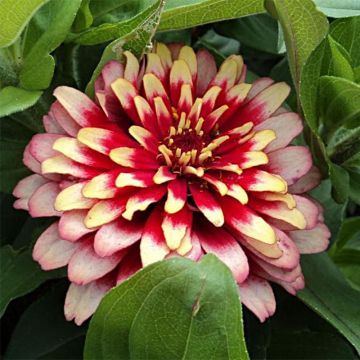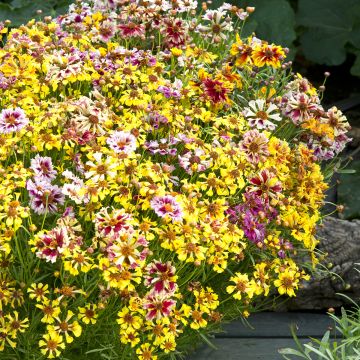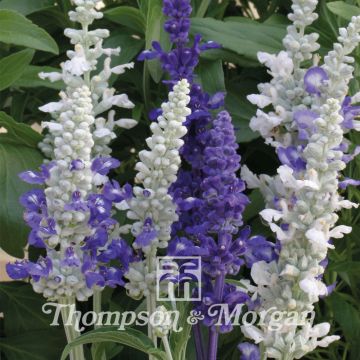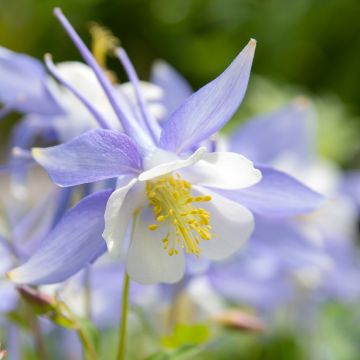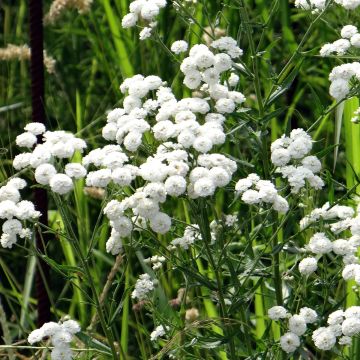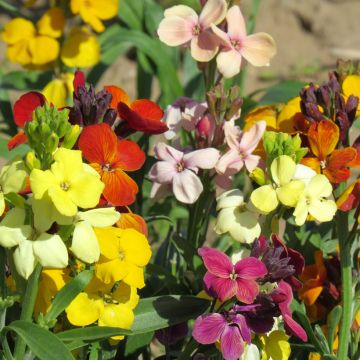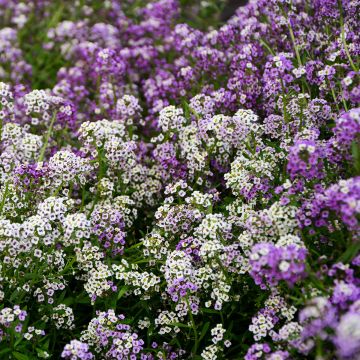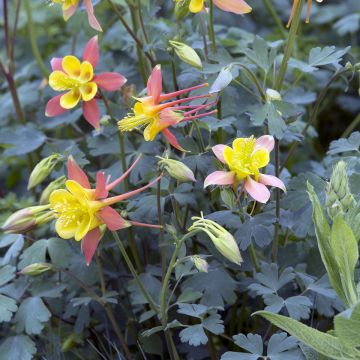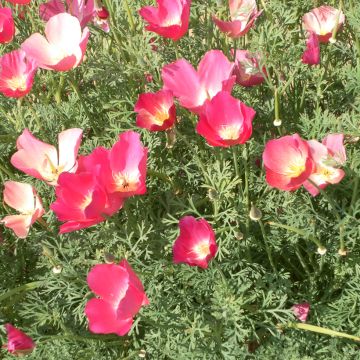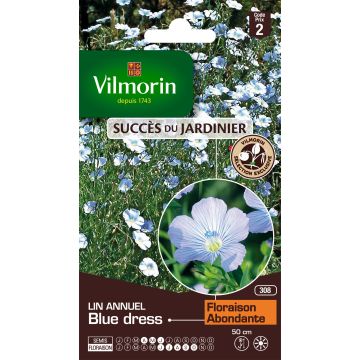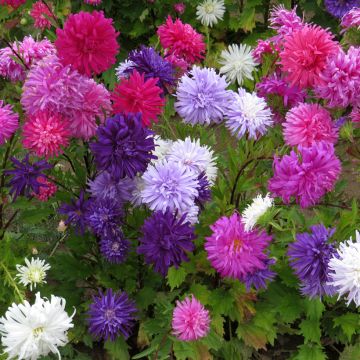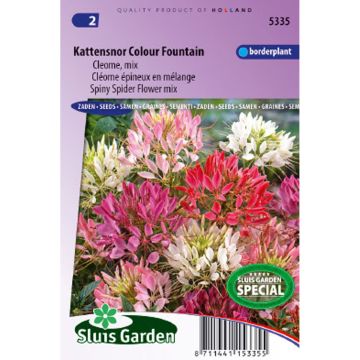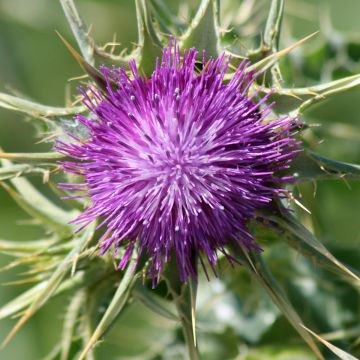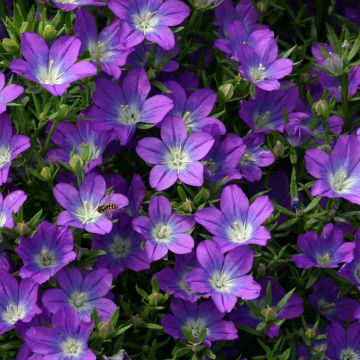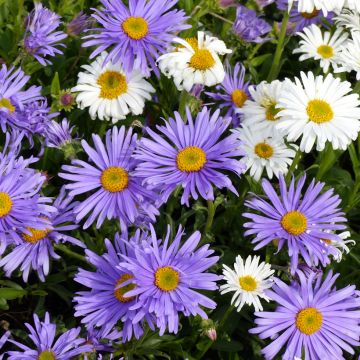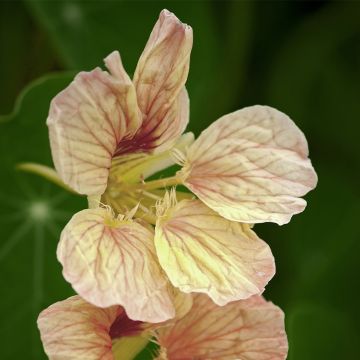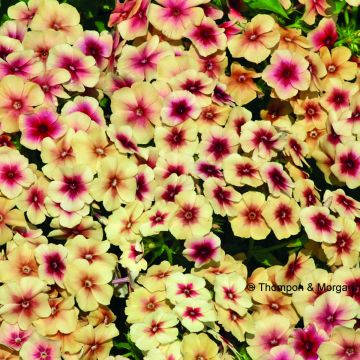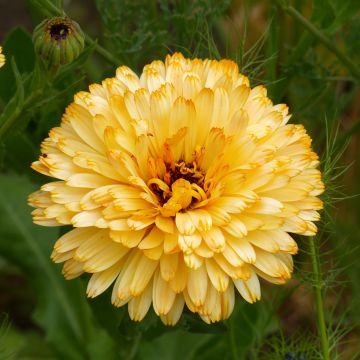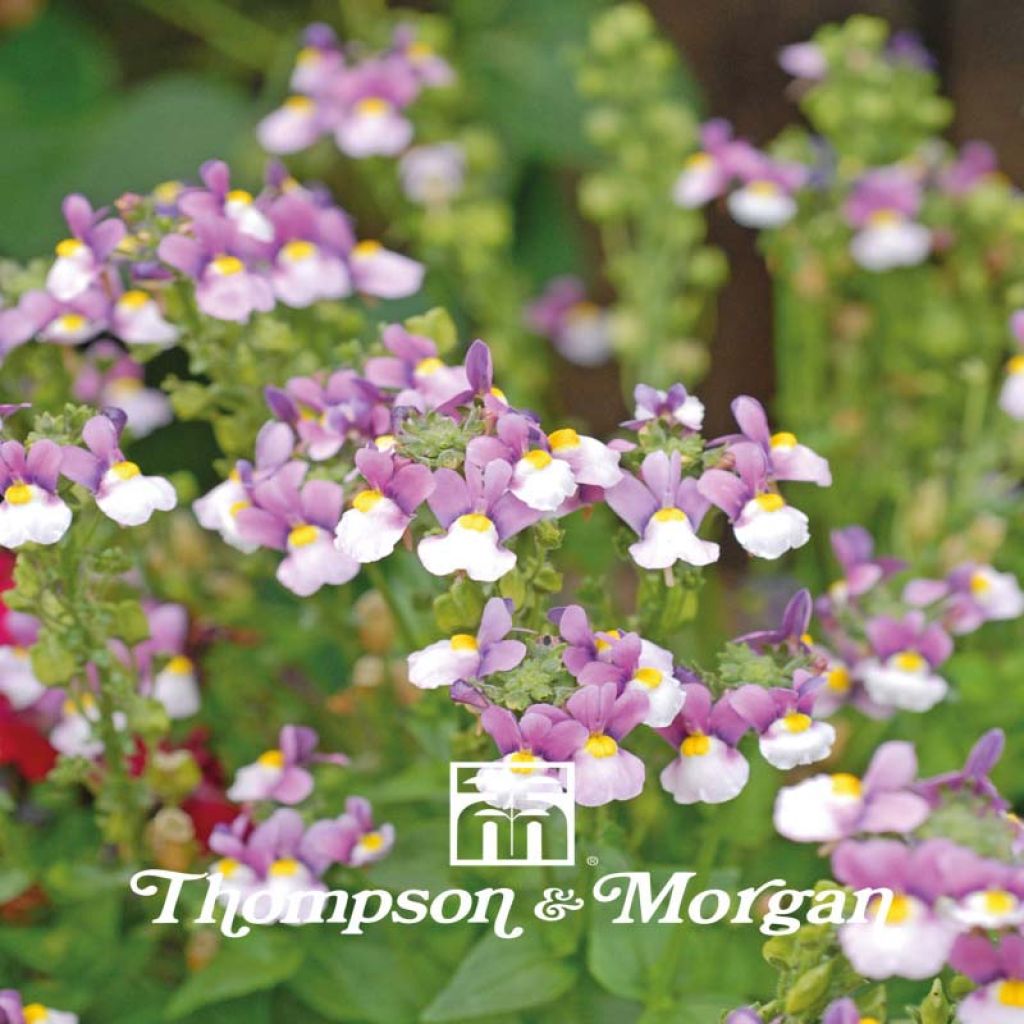

Nemesia Seventh Heaven Seeds
Nemesia Seventh Heaven Seeds
Nemesia Seventh Heaven
Cape Jewel
This item cannot be shipped to the selected country
Dispatch by letter from €3.90
More information
Schedule delivery date,
and select date in basket
This plant carries a 6 months recovery warranty
More information
We guarantee the quality of our plants for a full growing cycle, and will replace at our expense any plant that fails to recover under normal climatic and planting conditions.
Seed-only orders are dispatched by sealed envelope. The delivery charge for seed-only orders is €3.90.
Does this plant fit my garden?
Set up your Plantfit profile →
Description
Nemesia Seventh Heaven is a beautiful cultivar of Nemesia, featuring for the first time varieties with sizable, bicoloured flowers grown from seed. In just a few months, this Nemesia forms small, bushy, compact, branched clumps, covered with scented flowers in a mixture of lavender, white, violet and purple with a little pale yellow centre. This remarkable annual plant which flowers almost continuously from June to October creates a prodigous visual and olfactory effect in hanging baskets and planters.
Nemesia is a tender perennial or annual plant of the Scrophulariaceae family, native to South Africa. Through crossbreeding between different species, this plant is at the origin of many horticultural varieties whose performance in terms of quantity, quality and durability is constantly being improved. The cultivars in the 'Seventh Heaven' mix, grown from seed, have recently been selected for their large, bicoloured, fragrant flowers. This rather fantastic creation offers an almost continuous, fragrant flowering from May to October on low, well-branched plants that grow up to 30 cm high and 35 cm in diameter.
These compact Nemesia produce a multitude of ravishing tiny symmetrical flowers, 1-2 cm in size and whose colour varies from plant to plant. White, mauve, lavender, violet or purplish, they are bicoloured and centred on a golden yellow throat that is noticeable from afar. This exuberant flowering exhales a very pleasant scent of honey and coconut that attracts pollinating insects. Gathered at the tips of robust, leafy stems, these flowers seem to float on graceful clumps with a dense, rounded and upright habit. The foliage is made up of small, lanceolate, finely serrated, greyish green leaves. Very resistant to wind and rain, these cape jewels are hardy down to -3°C.
From the first days of spring, the radiant or pastel colours of Nemesia brighten the flowerbeds of our cities and villages. On our patios and in our gardens, these refreshing plants with their extremely graceful habit which is dense and light all at once, perfectly adorn hanging baskets, window boxes, all types of basins and even perennial beds, preferably in full sun. They are easy to grow in the garden and give spectacular results when they are planted in containers. Use them in borders, in a mix of different colours or in combination with geraniums, lobelias, annual Verbena and petunias etc... Reserve a spot for it near a passageway, on a patio or terrace, along the edges of paths or in any place where one can fully take advantage of its coconut fragrance. Nemesia combine particularly well with Dorotheanthe difformis with which they share the same origins and the same beautiful ground cover qualities.
Careful, seeds are reserved for very experienced gardeners that are used to sowing very fine seeds. These seeds are as fine as dust and are barely visible to the naked eye.
Report an error about the product description
Flowering
Foliage
Plant habit
Botanical data
Nemesia
Seventh Heaven
Scrophulariaceae
Cape Jewel
Cultivar or hybrid
Other Thompson and Morgan seeds
Planting and care
Sowing:
Sow the nemesia seeds from March to May. Sow thinly in the surface, in well-prepared, loose soil. Water regularly to maintain a certain moistness, especially throughout drier weather. You can also sow in pots or tubs filled with moistened special seed soil mix, by covering the seeds with a very small pinch of compost or vermiculite. Keep the seedlings between 20 and 25 °C. Light encourages germination. Keep the surface of the soil moist but not wet; germination takes 7 to 14 days. Transplant the seedlings into 7.5 cm pots or into tubs. Plant outdoors once there is no more risk of frost.
Culture:
Plant your nemesias in a sunny position or a partially shady one. They require a light, rich, humus-rich soil and appreciate being regularly fed. They don't tolerate well high temperatures combined with high humidity. You can plant your nemesias in flowerbeds or in pots. In a container, these plants have to be watered regularly. The planting is done as soon as the last frosts have passed, in the spring. In summer, during hot periods, do not hesitate to prune the plant severely (10 to 15 cm from the base) in between two waves of flowers in order to encourage the formation of new flowering shoots.
Sowing period
Intended location
-
, onOrder confirmed
Reply from on Promesse de fleurs
Flower seeds
Haven't found what you were looking for?
Hardiness is the lowest winter temperature a plant can endure without suffering serious damage or even dying. However, hardiness is affected by location (a sheltered area, such as a patio), protection (winter cover) and soil type (hardiness is improved by well-drained soil).

Photo Sharing Terms & Conditions
In order to encourage gardeners to interact and share their experiences, Promesse de fleurs offers various media enabling content to be uploaded onto its Site - in particular via the ‘Photo sharing’ module.
The User agrees to refrain from:
- Posting any content that is illegal, prejudicial, insulting, racist, inciteful to hatred, revisionist, contrary to public decency, that infringes on privacy or on the privacy rights of third parties, in particular the publicity rights of persons and goods, intellectual property rights, or the right to privacy.
- Submitting content on behalf of a third party;
- Impersonate the identity of a third party and/or publish any personal information about a third party;
In general, the User undertakes to refrain from any unethical behaviour.
All Content (in particular text, comments, files, images, photos, videos, creative works, etc.), which may be subject to property or intellectual property rights, image or other private rights, shall remain the property of the User, subject to the limited rights granted by the terms of the licence granted by Promesse de fleurs as stated below. Users are at liberty to publish or not to publish such Content on the Site, notably via the ‘Photo Sharing’ facility, and accept that this Content shall be made public and freely accessible, notably on the Internet.
Users further acknowledge, undertake to have ,and guarantee that they hold all necessary rights and permissions to publish such material on the Site, in particular with regard to the legislation in force pertaining to any privacy, property, intellectual property, image, or contractual rights, or rights of any other nature. By publishing such Content on the Site, Users acknowledge accepting full liability as publishers of the Content within the meaning of the law, and grant Promesse de fleurs, free of charge, an inclusive, worldwide licence for the said Content for the entire duration of its publication, including all reproduction, representation, up/downloading, displaying, performing, transmission, and storage rights.
Users also grant permission for their name to be linked to the Content and accept that this link may not always be made available.
By engaging in posting material, Users consent to their Content becoming automatically accessible on the Internet, in particular on other sites and/or blogs and/or web pages of the Promesse de fleurs site, including in particular social pages and the Promesse de fleurs catalogue.
Users may secure the removal of entrusted content free of charge by issuing a simple request via our contact form.
The flowering period indicated on our website applies to countries and regions located in USDA zone 8 (France, the United Kingdom, Ireland, the Netherlands, etc.)
It will vary according to where you live:
- In zones 9 to 10 (Italy, Spain, Greece, etc.), flowering will occur about 2 to 4 weeks earlier.
- In zones 6 to 7 (Germany, Poland, Slovenia, and lower mountainous regions), flowering will be delayed by 2 to 3 weeks.
- In zone 5 (Central Europe, Scandinavia), blooming will be delayed by 3 to 5 weeks.
In temperate climates, pruning of spring-flowering shrubs (forsythia, spireas, etc.) should be done just after flowering.
Pruning of summer-flowering shrubs (Indian Lilac, Perovskia, etc.) can be done in winter or spring.
In cold regions as well as with frost-sensitive plants, avoid pruning too early when severe frosts may still occur.
The planting period indicated on our website applies to countries and regions located in USDA zone 8 (France, United Kingdom, Ireland, Netherlands).
It will vary according to where you live:
- In Mediterranean zones (Marseille, Madrid, Milan, etc.), autumn and winter are the best planting periods.
- In continental zones (Strasbourg, Munich, Vienna, etc.), delay planting by 2 to 3 weeks in spring and bring it forward by 2 to 4 weeks in autumn.
- In mountainous regions (the Alps, Pyrenees, Carpathians, etc.), it is best to plant in late spring (May-June) or late summer (August-September).
The harvesting period indicated on our website applies to countries and regions in USDA zone 8 (France, England, Ireland, the Netherlands).
In colder areas (Scandinavia, Poland, Austria...) fruit and vegetable harvests are likely to be delayed by 3-4 weeks.
In warmer areas (Italy, Spain, Greece, etc.), harvesting will probably take place earlier, depending on weather conditions.
The sowing periods indicated on our website apply to countries and regions within USDA Zone 8 (France, UK, Ireland, Netherlands).
In colder areas (Scandinavia, Poland, Austria...), delay any outdoor sowing by 3-4 weeks, or sow under glass.
In warmer climes (Italy, Spain, Greece, etc.), bring outdoor sowing forward by a few weeks.

































